January 30, 2008
A Big Question Mark
Why is it that I can't see this kind of light installation being done in a church in America?
via swiss miss
January 25, 2008
Stained Glass Vision of William Blake
November 28th, 2007, was the 250th anniversary of the birth of William Blake. Around that time, I saw this Guardian article called Blakean Visions in south London. What caught my eye in the article was, of course, the image of a rather nice stained glass window, designed by John Hayward, from St. Mary's Battersea Old Church, London, England - the church in which Blake was married to Catherine Boucher in 1782.
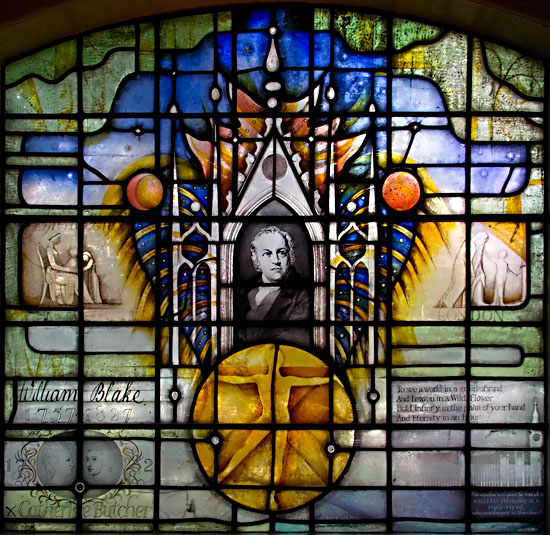
This photo (and all subsequent details of the Blake window) are courtesy of Flickrite mym, who has an amazing Flickr set of stained glass images. Thanks for the hi-res image, mym!
The church has a 'virtual tour' of their windows, with interesting information, starting with a rather funny story of just how 4 ground floor windows in a 1,000 year old church came to need new stained glass.
What interests me about this window are the references to Blake's work, in the details. What is referenced, how is it done and perhaps even a few thoughts on why ...
on to the details ...
from top left, then clockwise -
From the Title page of Songs of Innocence
The scene as depicted in the stained glass panel, with the original illustration detail on the right -
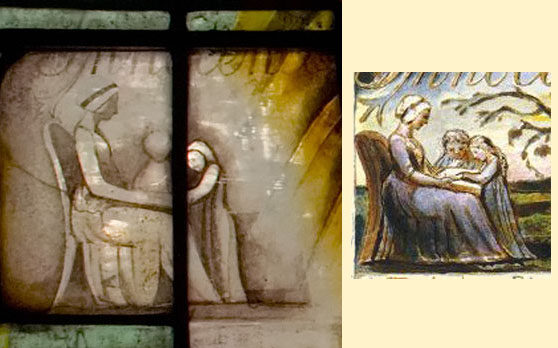
This is the illustration seen in context of an original full page...
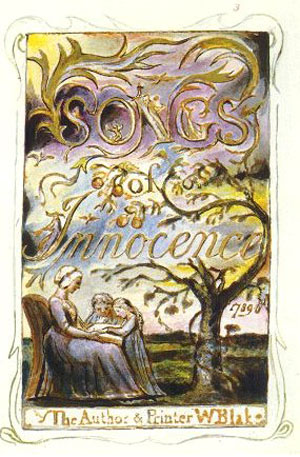
These "illuminated books" were all printed with a colored ink, then hand colored with watercolors. The William Blake Archive has an amazing collection of different versions of Songs of Innocence and of Experience.
This ia a screen shot of their comparisons on the WB Archive.
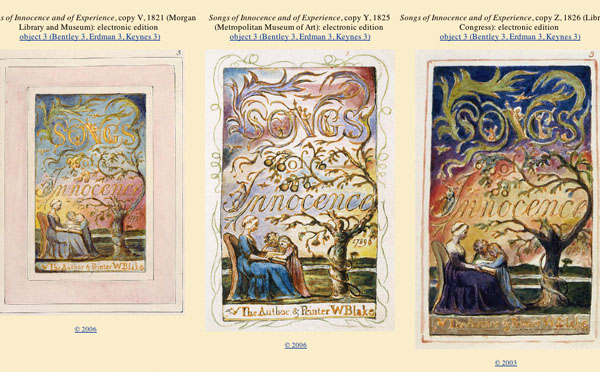
So, go to the William Blake Archive and drink it all in...
Central Portrait - William Blake
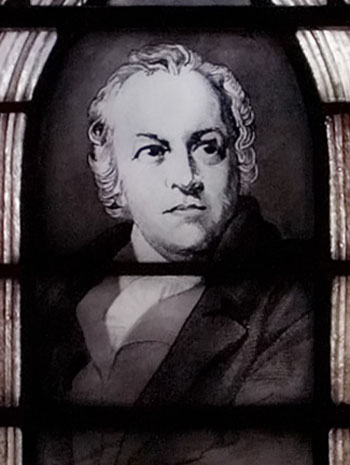
Derived from this Portrait of William Blake by Thomas Phillips -
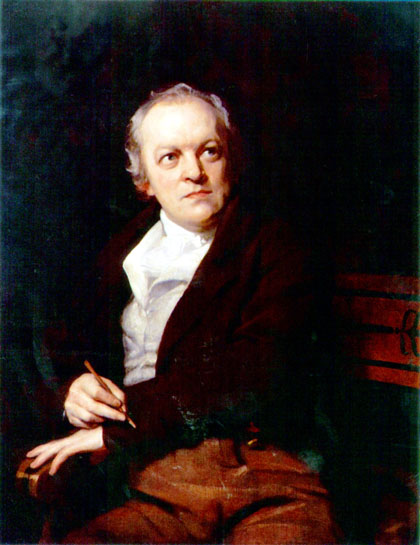
The painting is also the basis for this engraved version by Luigi Schiavonetti.
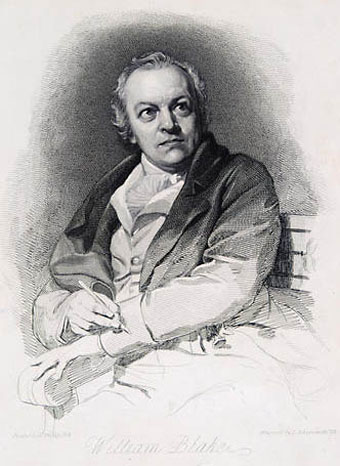
Here are all three faces placed together to provide a study in subtle facial differences. It may just be me, but I think the Hayward version makes Blake look a bit more refined and perhaps even aristocratic (which Blake certainly was not), while the Schiavonetti engraving seems to enhance the wild-eyed, visionary idea of Blake.
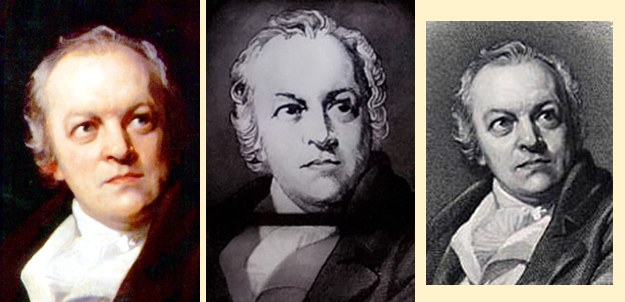
When I did my own Blake panel in the mid 1990's. I used the engraving by Schiavenetti (though altered to a soft focus) as the basis for the face, rather than the painting.
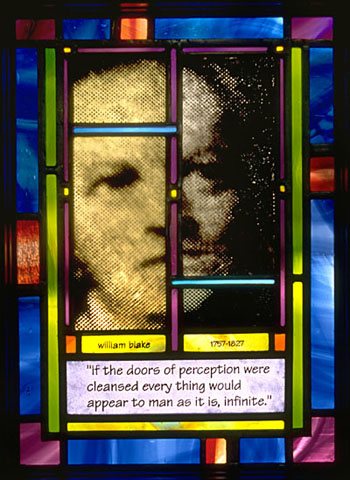
From London, in Songs of Experience
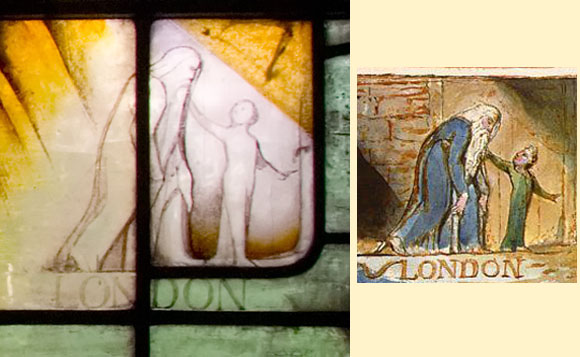
in context of the full page...
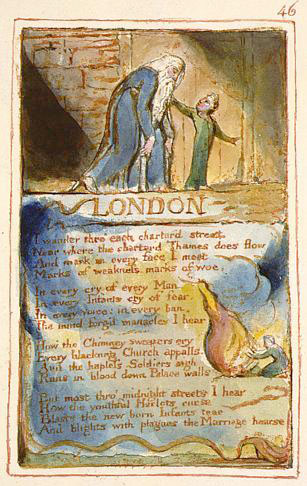
From Auguries of Innocence
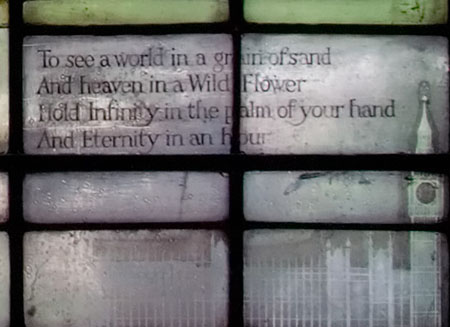
the quote -
To see a World in a Grain of Sand
And a Heaven in a Wild Flower,
Hold Infinity in the palm of your hand
And Eternity in an hour.
This is one of the most popular quotes from Blake. This expresses the notion of Blake as 'visionary', which can be interpreted as Blake literally seeing figures in thin air (which he did) or taken more figuratively as the notion of the importance of imagination.
The image of the Houses of Parliament is there to make a connection with the late William Hamling, MP, in whose memory the window was given.
Albion
and now... the most abstracted of the derivations
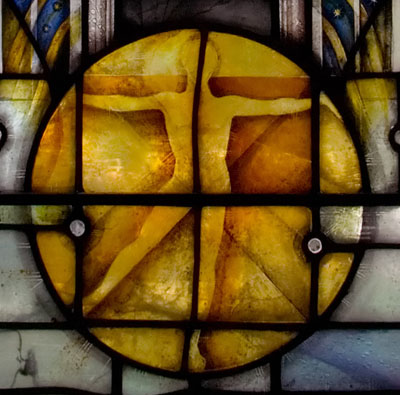
Derived from the painting called Albion.
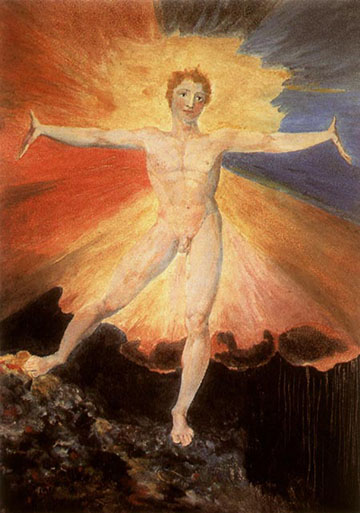
Albion was used by Blake both as a symbol for old England, and as one of the figures in his madcap pantheon of cosmological figures. One can only conjecture that the image was abstracted due to the fact that christian religious art rarely features full male frontal nudity... and notice how, even in this abstracted form, the leadlines seem to conveniently cross at the appropriate place, relieving the artist of the the decision of how to adequately abstract the male genitalia.
Drawn Portraits
Finally, there is this, which is a bit of a puzzle.
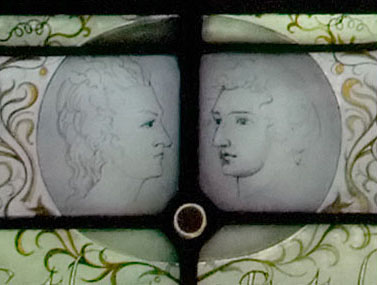
On first glance at this I did not recognize the specific images, other than to see that they were derived from drawings and to assume that the portrait on the left is a woman and the portrait on the right is a man. Well, both are derived from drawings, otherwise wrong.
This is text from the St. Mary's website -
The wedding is suggested by a wedding ring between two pencil portraits. The one of the left is William drawn by Catherine, the one on the right, Catherine as drawn by William.
So, the figure on the left is derived from this drawing of William by Catherine, with additional support for this from this page from the Tate website.
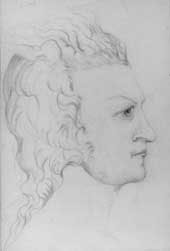
I couldn't find any drawing on the web or mention of a drawing that would show where the drawing for the the figure on the right is, but there is no reason to doubt that it is Catherine as drawn by William.
Academics have had a field day on theories regarding Blake and Gender, with unfortunate examples to be seen here, here, and here. I will not attempt to add to any such theories, but I will say that these two drawings have an untold story to tell.
In Conclusion...
One thing to keep in mind in viewing this window is that all the references to Blake and his work are to the 'safe' and 'family friendly' Blake, the Blake of Songs of Innocence and Songs of Experience. This window does not reference the 'mad' Blake, the 'visionary' blake, or 'outsider' Blake. The Blake of Ghost of a Flea or other visionary portraits, and nothing from the more incomprehensible prophetic books such as Jerusalem and Milton.
Understandable, seeing that the window is in a church.
Still, William Blake, surprisingly to me, cuts a big figure in contemporary popular culture, and that tends to feature the darker, weirder, or at least more visionary, Blake. There are even the appearances in mainstream movies that include brief references in comedies like Bull Durham and Talladega Nights: the Ballad of Ricky Bobby to more substantial references in darker films like Dead Man and the Red Dragon movies. This would not be the version of Blake likely to make it into church decoration.
My favorite of Blake's works is Marriage of Heaven and Hell, which is more in the middle in terms of Blakean weirdness. It's a little more readable and accessible, and seeing that it's structured as a series of short sections (memorable fancies, 'Proverbs of Hell', etc) you can read it in small sips.
My own well worn copy, which I've had for almost 30 years.
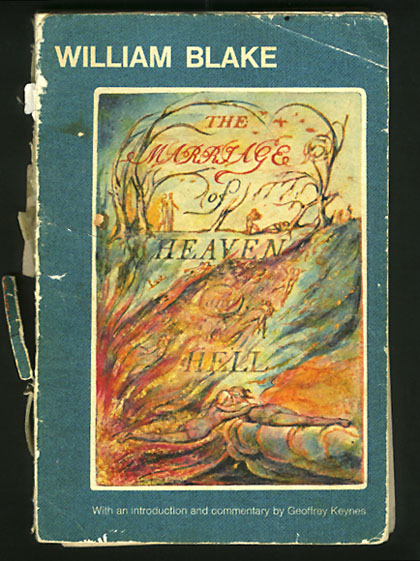
You can see it and read it for yourself here.
January 18, 2008
1000 Points of Peace
From the blog Mosaic Art and Glass Art - An article about the artist named Ragtime, who is a Vietnam Vet on a mission to create 1000 variations of the Peace Symbol in stained glass. As of this writing, he is at about #175. Up til now, as far as I can tell, he's only done these in a simple mosaic style, all in copper foil, with many of them incorporating fused glass and some of them all fused. Just a thought, but it would be interesting if some of them were done in lead came and some of them painted and/or stained...
1000 variations of any symbol is a pretty tall order...
#133 The Peace Wheel
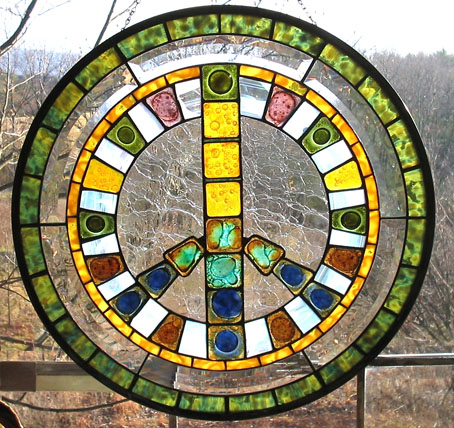
Though on the other end of the spectrum in terms of subject matter, this does remind me of skull-a-day, which is a blog about a guy who is currently in the midst of a project to create an image of a skull every day for one year, posting a new one daily. A recent entry is this image of a glass mosaic skull, and earlier he took a beginner's stained glass class to make a stained glass skull. This blog has garnered quite a bit of attention and, amazingly, he even landed a book deal!
[update - Feb 23, 2008 - Something I didn't know when I posted this is that 2008 is the 50th anniversary of the creation of the peace symbol, created by British designer Gerald Holtom for the Campaign for Nuclear Disarmament and that the symbol was created from a combination of the semaphore symbols for the letters 'N' and 'D'.]
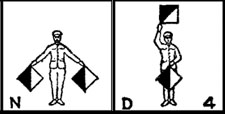
[update- March 22, 2008 - nice BBC online article on the 50th anniversary of the peace symbol.]
January 15, 2008
Googlebooking Stained Glass
Some mention on the Stained Glass H-net Forum recently of an old stained glass book being available on the web. So, being a curious fellow, I tried out a search at Google Books. It has a clunky and slow interface, but if you search a bit there are some interesting finds, especially old obscure books that are available in their entirety since the books are long in the public domain.
Searching for 'stained glass', I did find it -
Decorative Painters' and Glazier's Guide by Nathaniel Whittock, this edition with a publication date of 1828. This book is interesting as an early stained glass "How-to" book, especially in that this was well before the age of the stained glass supplier, so there are recipes in here for making the glass (though not descriptions of HOW to make the glass), as well as recipes for making your own paint and silver stain. Mostly the book concerns itself with methods of painting and staining on clear crown glass. Pages 204-304 are the ones related to stained glass.
This plate of illustrations comes just before page 243.
It is one of only a few hand-colored plates in the book.
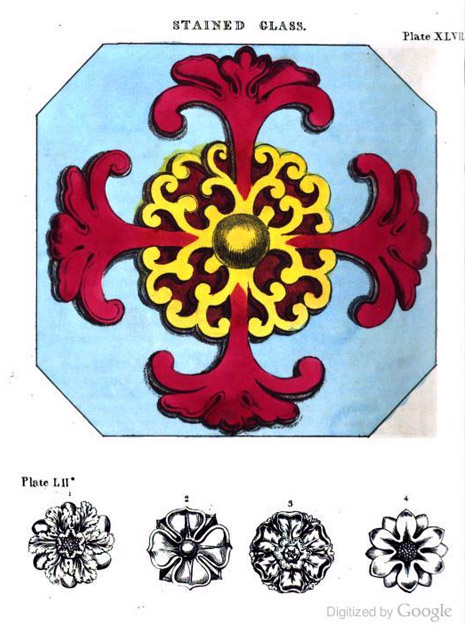
This page contains paint formulas.
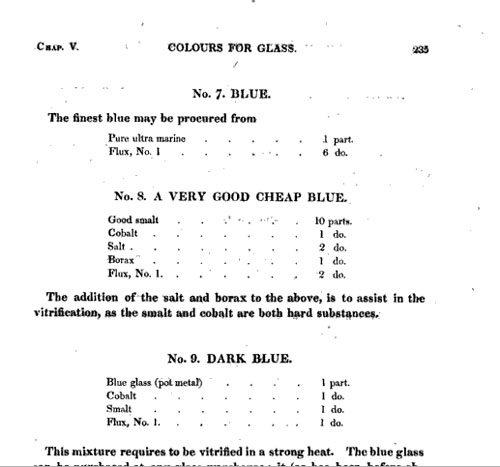
If you are truly interested in giving this a serious read-through, then I would recommend downloading the pdf and printing out the stained glass section.
Another full book about stained glass is this one published in 1922 - Stained Glass, by Alfred Werck. You can tell he's a little bristly, and opinionated by the subtitle -
"A Handbook on the Art of Stained and Painted Qlass, Its Origin and Development From the Time of Charlemagne to Its Decadence (850-1650)". Personally, I like decadent stained glass....
January 06, 2008
Tio's Tacos
Via Extreme Craft, a flickr set of Tia's Tacos, in Riverside CA, with its folk art environment including a bottle wall chapel. Alas, the only interior shot...
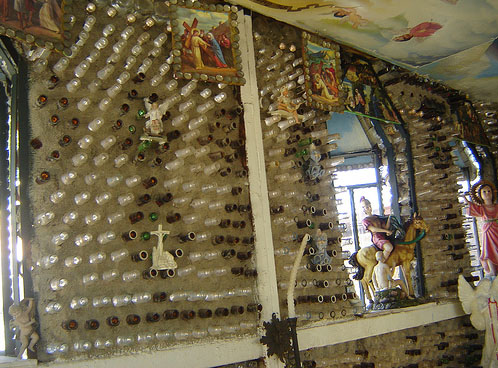
Also, look at some very nice shots of the same place, with better interior shots, on this unusuallife.com 'Riverside California Folk Art' post.
January 01, 2008
Crafty Bloggy Things
Lazy New Year's day and so I'm checking out some blogs that are marginally or occassionally dealing with stained glass or glass art.
Extreme Craft
In this globalized consumer-based economy, it can be pretty radical to suggest that you make your own stuff - and even more so when it's the distinctly out-of-the-ordinary stuff promoted on this blog. Craft hard, Garth!
American Craft Magazine + Blog
A few months ago, American Craft Magazine introduced its new look, part of its attempt to revamp its image. It's now redone the website, which has taken on a distinctly 'bloggier' look. On top of this, there is the 'official' blog, Zoom. All nice improvements, though I must admit I don't see the big difference between the magazine 'site' and the official 'blog'. My advice - IMHO - drop the blog and make the magazine site the blog/site, and please... lose the name 'Zoom', it has zero connection to the idea of craft and sounds so much like it was come up by some marketing consultant desperately trying to make boring old 'Craft' sound hip and young. It doesn't work.
Craftzine Blog
Despite the way too many ads cluttering the site, this is a good general non-conventional craft blog. Covers more of the 'crafter' world rather than the 'fine craft' world of American Craft and that's just fine by me. The posts are generally good and there is much unusual work to be seen, like this stained glass shopping cart.

Official Title - 'Have and Have Not", by Chrystal Schenk
as featured on Craftzine Blog in May of 2007.
and I stumbled on all these mosaic blogs - I'd no idea there were so many...
Mosaic Art and Glass Art
A mosaic artist does a blog, and also deals a bit with stained glass.
Not much commentary but prolific, often several posts a day, nearly every day! Yikes.
Make Mine Mosaics
Out of Australia, I believe. Many, many images of mosaic art.
The Joy of Shards
English in origin with lots of interesting links throughout the entire site.
For instance, this page on 'Picassiette', which, in today's terminology, is the creation of mosaics using recycled ceramics. That is - broken pottery, tiles, dishes, glassware, etc. They even try to establish a link between this and what I always call the English Jumble Window. It's an interesting hypothesis, especially when they put it in context with a visit to Winchester Cathedral, but I'm still not sure that the motivations were the same.
Kim Grant Mosaic Blog
Do check out the Amazing, Creepy Social Realist North Korean Mosaic Mural.